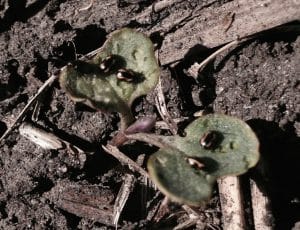
Flea beetle pressure is quite high in many locations. Spraying may be necessary. If damage was quick and devastating, growers may face a reseeding decision.
Early scouting is necessary to make sure the seed treatment provides enough protection. Here’s why: (1) Flea beetles need to take a bite of the plant in order to take up the insecticide, so there will be some feeding even while the seed treatment is working. In some cases, intense nibbling by a very large flea beetle population could overwhelm the seed treatment. (2) Seed treatments may wear out in slow germinating or growing crops before the plants are large enough to tolerate much feeding. And (3), the two most common seed treatment insecticides may be a bit less effective on striped flea beetles, so check which one is most common in your field. Most areas of the Prairies have both striped and crucifer flea beetle species.
The economic threshold for flea beetles in canola crops in Canada is an average defoliation level of 25% or more of the seedling leaf area. The point at which foliar insecticide provides an economic benefit could be when damage reaches 50%, but feeding can reach this stage fairly quickly when flea beetle numbers are high and damage is already at 25%.
Further reading:
The 8-step process to determine if a flea beetle spray is warranted.
Flea beetle thresholds and frost
Estimating flea beetle damage in canola
Top 10 things to look for after emergence

